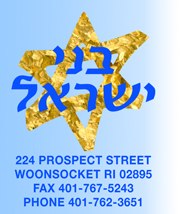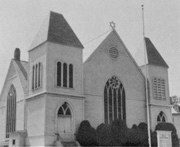Congregation B’nai Israel History


September of that year voted to integrate the “Polo Street Congregation,” not further identified.
Three years later a charter was issued to the Woonsocket Hebrew Mutual Aid Association for the purpose of sharing “social and literary culture” and for “mutual aid, charitable and educational purposes.” In 1906 the Woonsocket Gemiles Chesed Association, a charitable society, was formed.

According to the Woonsocket City Directory for 1900, peddlers (21) predominated among occupations of the Jewish residents, followed by people connected with the clothing business (19). The list also included an oculist (optometrist), a bookkeeper, a laborer, an overseer, a hairdresser (barber), a restauranteur, two cobblers, a grocer, and two dealers in fruit, one of whom had previously given his occupation as a butcher.
The large number of peddlers in Woonsocket is not surprising. Surrounded as it was by farms and villages, the city offered opportunities for earning a living by peddling, if one wished to invest long hours and hard work in the venture. Then, too, peddling required little in the way of capital or specialized training; immigrants usually lacked both. And so, often on foot, sometimes with horse and wagon, peddlers from Woonsocket traveled though
The following is edited from an article that appeared in Rhode Island Jewish Historical Notes (Vol. II, No. 3, November, 1993), a publication of the Rhode Island Jewish Historical Association. The article, titled “100th Anniversary of B’nai lsrael, Woonsocket – 1993” was adapted from a talk given by Geraldine S. Foster, past president of the Association, at Congregation B’nai Israel on May 19, 1993, in honor of the opening event of the congregation’s 100th anniversary celebration.
During the post Civil War period, while the Jews in Providence were building their community and developing its institutions, a scattering of their co-religionists moved to the smaller towns of Rhode Island, notably Newport, Westerly, and Woonsocket.
The distinction of being the first Jewish settler in Woonsocket belongs to Solomon Treitel, who came from Boston. Treitel’s advertisement for his clothing business stated that his firm was established in 1873, although, according to Congregation B’nai Israel archives, he had come to Woonsocket in 1866.
By 1889, the Jewish population had grown sufficiently to support a congregation, Lovers of Peace, which received its charter from the state four years later in 1893. The incorporators were Solomon Treitel, Michael Jacobson, Phillip Hopp, Harris Fellman, Bernard Goldonofsky, and Samuel Schlansky. Treitel served as president. Initially the members held services in a loft on South Main Street. The congregation flourished; three years later it had a Sunday school, land for a cemetery, and a Hevra Kaddisha (burial society).
Meanwhile, another group applied for and received a charter as the Woonsocket Congregation Sons of Israel. The year was 1895.
When Lovers of Peace began to meet under the leadership of a lay reader, the congregation had the use of a Sepher Torah (Scrolls of the Law) procured by Samuel Schlansky from the Congregation Sons of Israel and David, Temple Beth-EI, Providence.
In January of 1902, the Congregation of the Lovers of Peace officially changed its name to B’nai Israel, and in


OUR HISTORY



Color photographs by Robert Golden